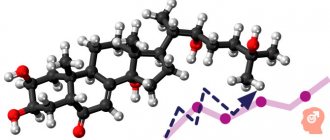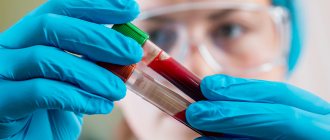Progesterone test
Progesterone is one of the main steroid hormones of the human body, the production of which is responsible for the adrenal cortex. Progesterone has high hormonal activity and is also a direct precursor to estrogens, androgens and corticosteroids.
Progesterone is present in the body of both men and women. The hormone circulates in the blood serum - it is by studying it that the concentration of this substance in the body can be determined. In the follicular phase of the menstrual cycle, the content of progesterone in the blood during the analysis remains low. The concentration of this substance in a woman’s body increases significantly after ovulation - active production of the hormone by the corpus luteum begins. Progesterone has a direct effect on the launch of a number of processes in the body of women, including preparation for implantation of a fertilized egg. If fertilization has occurred, the body begins to produce hCG - it is by its level that one can confirm or deny pregnancy in the earliest stages. This substance supports the corpus luteum and the secretion of progesterone in it.
By the end of the first trimester of pregnancy, the placenta takes on the main role in the secretion of progesterone in the female body. As pregnancy progresses, the concentration of the hormone in the blood serum continues to increase steadily. If implantation of a fertilized egg does not occur within a certain period of time, the corpus luteum is destroyed, after which the amount of progesterone circulating in the body decreases significantly. After just a few days, the level of this hormone reaches the level observed in the follicular phase.
Steroid synthesis is a very complex biological process. It begins with the synthesis of cholesterol from acetate. The direct precursor of progesterone is pregnenolone. The main metabolite of progesterone in the liver is pregnanediol, which is synthesized by the body and then excreted by the kidneys. Progesterone is transported throughout the body exclusively in conjunction with other steroid hormones.
Pregnant women have a blood test for progesterone to assess the progress of pregnancy. If the concentration of progesterone increases, pregnancy proceeds normally. If the level of progesterone in the blood has not increased, a number of other specific tests, including ultrasonography, must be performed to confirm the viability of the fetus. Serum progesterone concentrations peak and stabilize at approximately 8–10 weeks of pregnancy. If this does not happen or the hormone level decreases, a disruption in the normal course of pregnancy may occur.
After 10-12 weeks of pregnancy, the concentration of progesterone in the blood serum begins to increase again, however, analysis for this hormone in late pregnancy is not informative in diagnosis. This test is best suited to determine the time of ovulation and the presence of a functioning corpus luteum. In this way, it is possible to diagnose luteal phase dysfunction - but only if ovulation has occurred, and progesterone production during this period is significantly lower than normal levels.
Explanation of progesterone analysis
Progesterone levels depend on the age and gender of the patient, in a woman - on the day of the menstrual cycle, and during pregnancy - on the period. Units of measurement: nmol/l. Alternative units: ng/ml. Conversion of units: ng/ml x 3.18 ==> nmol/l. Reference values
| Age | Progesterone level, nmol/l | |||
| Men | Women | |||
| < 9 years |
| < 1,1 | ||
| 9 – 18 years | ||||
| Puberty, Tanner stages | ||||
| Stage 1 |
| < 1,1 | ||
| Stage 2 |
| < 1,8 | ||
| Stage 3 |
| 0,3 — 14,4 | ||
| Stage 4 |
| 0,3 — 41,6 | ||
| Stage 5 |
| 0,3 — 30,4 | ||
| > 18 years old |
| After puberty and before postmenopause | Follicular phase | 0,3 — 2,2 |
| Ovulatory phase (mid cycle) | 0,5 — 9,4 | |||
| Luteal phase | 7,0 — 56,6 | |||
| Postmenopause | < 0,6 | |||
| Pregnant | I trimester | 8,9 — 468,4 | ||
| II trimester | 71,5 — 303,1 | |||
| III trimester | 88,7 — 771,5 | |||
How to donate blood for hormones?
Murzaeva Irina Yurievna
Endocrinologist, Preventive Medicine Doctor
December 13, 2011
It has become good practice to check your hormonal levels even before any health problems begin. Below I will talk about the rules for taking tests; to make the search easier, we will “divide” the hormonal levels into systems.
- Hormones of the thyroid gland, parathyroid glands. These are TSH, free and total T4, free and total T3, antibodies to TPO, antibodies to TG, antibodies to rTSH, some others - calcitonin, parathyroid hormone. They must be taken on an empty stomach (that is, “empty stomach”), or 4-5 hours after eating. Tablets (such as L-thyroxine, Euthyrox, Tyrosol, Mercazolil, etc.) are taken after the test. If you have been ill or are suffering from ARVI, ARI, it is better to get tested 4-5 weeks after recovery. These tests have no connection with the menstrual cycle.
- Sex hormones (for women).
 These are LH, FSH, estradiol, progesterone, prolactin, testosterone (free and total), DHA-S, 17-OH-progesterone, androstenedione, dehydrotestosterone. It is advisable to take the test on an empty stomach, for prolactin - for 2 days, refrain from intense physical activity, drinking alcohol, or sex. Take it after the temperature drops, in the morning 1-2 hours after waking up (preferably no later). Taking medications, not only hormonal ones, is also taken into account (therefore, present a list of medications you are taking to the doctor, and do not describe their approximate appearance with words - “well, these are white, small, in a blue box, in general, I don’t remember what they are called”) FSH, LH , ESTRADIOL, TESTOSTERONE, DHA-S, 17-OH-PROGESTERONE, ANDROSTENDEDIONE, PROLACTIN - given on 2-5 days from the start of menstrual bleeding (this is the 1st phase of the cycle) with a 28-day cycle, with a cycle of more than 28 days - 5-7 days , including after bleeding caused by progesterone, on days 2-3 with a cycle of 23-21 days. PROGESTERONE, sometimes PROLACTIN is taken on days 21-22 of a 28-day cycle (phase 2), or calculated on days 6-8 after ovulation (if an ovulation test was performed). DEHYDROTESTOSTERONE is given on any day of the cycle. For men, the test conditions are the same (hormones are slightly different)
These are LH, FSH, estradiol, progesterone, prolactin, testosterone (free and total), DHA-S, 17-OH-progesterone, androstenedione, dehydrotestosterone. It is advisable to take the test on an empty stomach, for prolactin - for 2 days, refrain from intense physical activity, drinking alcohol, or sex. Take it after the temperature drops, in the morning 1-2 hours after waking up (preferably no later). Taking medications, not only hormonal ones, is also taken into account (therefore, present a list of medications you are taking to the doctor, and do not describe their approximate appearance with words - “well, these are white, small, in a blue box, in general, I don’t remember what they are called”) FSH, LH , ESTRADIOL, TESTOSTERONE, DHA-S, 17-OH-PROGESTERONE, ANDROSTENDEDIONE, PROLACTIN - given on 2-5 days from the start of menstrual bleeding (this is the 1st phase of the cycle) with a 28-day cycle, with a cycle of more than 28 days - 5-7 days , including after bleeding caused by progesterone, on days 2-3 with a cycle of 23-21 days. PROGESTERONE, sometimes PROLACTIN is taken on days 21-22 of a 28-day cycle (phase 2), or calculated on days 6-8 after ovulation (if an ovulation test was performed). DEHYDROTESTOSTERONE is given on any day of the cycle. For men, the test conditions are the same (hormones are slightly different) - Adrenal hormones. (These are cortisol, renin, aldosterone, metanephrine, normetanephrine, adrenaline, norepinephrine, etc.). Take on an empty stomach, preferably between 8-9 am (daily peak secretion - more related to cortisol!). Before donating renin, aldosterone, metanephrines, etc., take some groups of medications for 2 weeks: Veroshpiron, and ACE (enalapril), B-blockers (Egilok), Aspirin and some others.
- Hormones of the pituitary gland (the main endocrine gland). These are: ACTH, growth hormone (growth hormone). I have already told you about FSH, LH, prolactin. ACTH is given as cortisol, on an empty stomach, 8-9 am, sometimes at 13.00 (and/or 20.00) - as prescribed by the doctor. STG (ego analogue of IGF1) on an empty stomach, at any time.
- The hormone insulin is given on an empty stomach, usually along with blood sugar. Sometimes together with a test for “glucose tolerance” (then 2 times - on an empty stomach and 2 hours after the “sugar syrup”).
- 24-hour urine testing (17-KS and 17-OX) is not currently used; the reliability of these tests is very low. But daily urine testing for cortisol is often done! To do this, urine is collected 24 hours from 8.00 one day to 8.00 another day (the entire volume of collected urine is recorded), it is mixed and 150-200 ml is brought to the laboratory, along with a record of the allocated volume. Some laboratories ask you to bring all your urine, you need to clarify this issue in advance! The same applies to 24-hour urine a) for calcium and phosphorus, b) metanephrines c) vanillylmandelic acid (for these you need to take a special preservative from the laboratory! to collect urine). When collecting daily urine, the following are excluded from the diet: beets, carrots, bananas, turnips, citrus fruits, and calcium supplements.
In endocrinology, hormonal tests are also used, but they are a separate topic.
Decoding indicators
If in the transcript of the analysis the progesterone indicator is indicated in ng/ml, then to obtain the most accurate indicator it is necessary to divide the figure by 3.18. The level of progesterone in the blood of boys and girls before puberty is the same and is less than 1.1 nmol/l. With the entry into adolescence, the beginning of hormonal changes and the active formation of sexual function, norms become different for children of both sexes. The production of progesterone outside of pregnancy largely depends on the stage of the menstrual cycle.
What is progesterone
Progesterone is a hormone that helps the female body prepare for conception, allows the fertilized egg to implant in the uterus and provides nutrition to the embryo.
On average, pregnant women have progesterone levels that are approximately 10 times higher on the Progesterone Test than non-pregnant women. For men, this hormone is also important Progesterone, although it does not play such a significant role.
Lifehacker has already written in more detail about how progesterone affects the body in a separate article. And here we will find out why it is necessary to measure the level of the hormone in the blood and what its deficiency or excess may indicate.
Tests for coronavirus
- Test for coronavirus
- Coronavirus test for organizations
- Testing for coronavirus at home
- Testing for coronavirus at home in 12 hours!
- Testing for coronavirus in Lyubertsy in 12 hours!
- Testing for coronavirus in Nekrasovka in 12 hours!
- Testing for coronavirus in Korolev in 12 hours!
- Test for coronavirus on the Sokol metro station
- Coronavirus test at Kolomenskaya metro station
- Coronavirus test at Voykovskaya metro station
- Test for coronavirus in Nekrasovka
- Coronavirus test in Korolev
- Test for coronavirus in Lyubertsy
- Test for coronavirus in Mytishchi
- Test for coronavirus at home Mytishchi
- Test for coronavirus at home Korolev
- Test for coronavirus at home Lyubertsy
- Test for coronavirus at home Nekrasovka
Any tests can be taken at clinics in the East Clinic network.
What is the normal level of progesterone in the blood?
Progesterone levels are measured in nanograms per milliliter (ng/ml) or nanomoles per liter (nmol/L).
The progesterone norm for adult men (over 18 years of age) is PGSN - Clinical: Progesterone, Serum less than 20 ng/ml. In children and adolescents, the upper limit can reach 0.35 ng/ml.
In women, the situation is somewhat more confusing, since progesterone levels are closely related to the phase of the monthly cycle or the duration of pregnancy. The standard normal limits look like this:
- In the first half of the monthly cycle before ovulation: less than 0.89 ng/ml.
- During ovulation: less than 12 ng/ml.
- After ovulation: 1.8–24 ng/ml.
- In the first trimester of pregnancy: 11–44 ng/ml.
- In the second trimester of pregnancy: 25–83 ng/ml.
- In the third trimester of pregnancy: 58–214 ng/ml.
Please note that the range of normal values may differ slightly from those given above. This depends on the specific laboratory and the reagents that are used in it. Therefore, it is important to pay attention to the values indicated on the study form.
Why are progesterone levels elevated?
Among women
Elevated progesterone can Progesterone Test mean this:
- You are pregnant.
- You are pregnant with two or more children.
- Pregnancy develops with some pathologies.
- You have cysts on your ovaries.
- There is a risk of ovarian tumors.
In men
An increase in hormone levels may indicate Progesterone about the following disorders:
- Excessive production of progesterone by the adrenal glands.
- Congenital adrenal hyperplasia.
- Adrenal cancer.
Analysis transcript
It takes about a day to decipher the results of the analysis. The next day after the study, the doctor issues a conclusion about the concentration of progesterone in the blood. It can be increased, decreased or have a normal value.
Pathologies in which progesterone levels are increased
An increase in progesterone is possible with the following pathologies:
- The presence of dysfunctional uterine bleeding.
- Absence of menstruation due to another disease.
- Tumor-like formations of the ovaries or testicles.
- Functional kidney failure.
- Neoplasms in the area of the adrenal glands.
During pregnancy, progesterone may be elevated under the following conditions:
- Bubble drift.
- Untimely maturation of the placenta.
- Pathology of the fetoplacental complex.
Pathologies in which progesterone levels are reduced
If after the study a decrease in the amount of progesterone in the blood is determined, this may indicate the following pathological conditions:
- Increasing the amount of estrogen in the body.
- Lack of ovulatory processes.
- Uterine bleeding.
- Absence of menstruation of various origins.
- Functional failure of the genital organs.
- Taking certain medications that help lower progesterone.
- Exacerbation of chronic inflammatory diseases of the genital organs.
The pregnancy period may be accompanied by a decrease in the amount of progesterone in the presence of a threat of miscarriage, insufficient development of the placenta, intrauterine growth retardation,
Indications
Experts identify the following indications for which it is necessary to determine the concentration of progesterone:
- Irregularity of the menstrual cycle or its complete absence.
- Infertility of unknown origin.
- Presence of bleeding from the genitals.
- Monitoring the condition of the placenta in the second and third trimester of pregnancy.
- Determining the reasons for post-term pregnancy.
A correctly determined progesterone concentration helps to determine the causes of pathology and correct them in a timely manner.










